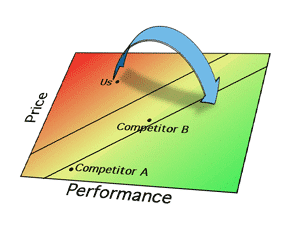Finding the Sweet Spot of Competitive Positioning
The sweet spot of competitive positioning ensures your brand is relevant to the target audience and differentiated from the competition. This article from Sawtooth Technologies pinpoints ways to position your brand, particularly in the business-to-business market.
Where should a brand be positioned? Although this is a straightforward marketing question, finding the right answer can appear complex. At the same time, in an increasingly competitive marketplace, finding the right answer has never been more important. Companies face the challenge every day of developing a winning positioning that will solidify their place in the market, set the direction for their marketing and sales, and drive the growth needed to succeed.
A winning positioning should be one that is relevant to the target audience and differentiated from the competition. So how do we determine that? And, with everything that is riding on the importance of positioning, how do we do it well?
The short answer is we find the sweet spot of competitive positioning. The sweet spot is where there is alignment across three key dimensions:
Importance of a feature or benefit to the target market
High performance on that feature or benefit by your brand/product
Weaker position by your major competitors on that feature/benefit
This is particularly relevant in a B2B market, where functional attributes tend to drive product decisions. However, it’s one thing to understand the concept of a sweet spot, but it’s another thing to find it. We will briefly discuss each of the above dimensions as well as some ways to identify them, and therefore, find the sweet spot.
Importance to the market
Your brand or product may really excel in a particular area, but does the market care? Finding the sweet spot of competitive positioning necessitates determining what features or benefits are most important to the market. There are a number of approaches to determining attribute importance, from straightforward rating or ranking questions (which may not differentiate much between attributes), to more elegant approaches such as MaxDiff, to more complex approaches, such as conjoint analysis or discrete choice, which may be appropriate if the tradeoffs across attributes are important.
High brand performance
What is your brand really good at? On which features does the market recognize that it really excels? Now, which of those are the important ones? Here, you want to make sure that the market recognizes what you’re good at and that you recognize what the market thinks you’re good at. And, you want to make sure that it matters. If you know that you excel in a certain area, either through independent tests, customer feedback, etc. and that attribute is important, you want to be sure the market hears about it, especially if it’s an attribute where your competition is weak. Brand performance can be determined by comparing your brand’s performance on various attributes vs. your competition. Both straightforward questions as well as the perceptual mapping technique, which gives a graphic snapshot of the competitive landscape, can achieve this.
Weak competitive performance
You want to own your positioning. Volvo owns safety. Google owns search. What do you own? What can you own? It’s not a winning positioning if your competitors match or exceed your brand performance in the same area. Look for differentiation among perceptions of your brand and your competitors’ – or determine how to create differentiation on an attribute that matters to your market. You want a point of difference that is believable and sustainable. And while it is desirable to own your positioning in the eyes of the entire market, it is even more essential to own it in the eyes of your target segments.
Summary
The sweet spot of competitive positioning is the point where three things converge: high importance to the market, high brand/product performance, and weaker competitive performance. Finding the sweet spot is a matter of understanding the needs and perceptions of your market to uncover how your brand best fits on those three dimensions. And once you find it, leveraging the sweet spot can help you thrive in a competitive marketplace.




